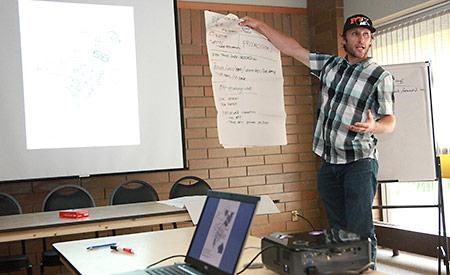When offered an opportunity to provide design ideas for Powell River’s new bike park and upgraded skateboard park, potential users were eager to jump to it.
Representatives of the two companies building the joint facility at Powell River Recreation Complex site revealed preliminary design features at a meeting at the complex on Thursday, August 14. More than 40 people attended the meeting, the second in a week during the pre-construction consultation phase.
The facility, funded by a grant of up to $550,000 from the Powell River Community Forest, will be built adjacent to the recreation complex, in the vicinity of the existing skateboard park.
“It’s unique in that we are bringing two separate projects together,” said Jim Barnum, president and project manager of Spectrum Skate Parks Inc. “I haven’t seen where there is a skate park and a bike park adjacent and working together.”
Barnum said the one of the matters the builders want to address during the process is creating something of benefit to the greatest cross-section of the community. Other goals include constructing a park that is going to look great in 20 years and build upon the community’s very popular biking sector. He added that the facility could potentially become a very big tourist attraction down the road.
Barnum said at the first meeting, he heard some great ideas and thoughts; some of which have been integrated into the plans shown at this second meeting.
“I’m very pleased with the way things went [at the first meeting] last week,” he said. “We received some good feedback, through Facebook, email, telephone calls.”
He said the intention of the second meeting was to determine if he had heard the contributors correctly about the features they would like integrated into the new facility.
Barnum then led a discussion about the design of the skate park, taking those in the audience through a series of slides showing proposed features. He said in designing the skateboard park, he does not want to see a whole lot of money spent on aesthetics.
“We want to put the money into function,” he said. This will include features that provide a lot of sensation and movement for the riders.
The new skateboard park will use components of the existing skate park at the recreation complex. The footprint of the new skateboard facility will be 40 feet width to a little more than 100 feet in length, according to Barnum.
When asked when the facility would be ready, Barnum said November.
Judd de Vall, founder and principal owner of Alpine Bike Parks Canada Inc., was the second presenter and said the designers were looking at designing for a very long lifespan. The goal is to involve the community in the planning, to have them love it and make it their own, he said.
Also important in creating a multi-generational facility such as the one being proposed, is the requirement to design features which will be usable by a broad spectrum of riders.
“The sky is the limit for bringing ideas to the table,” he said.
After the meeting, de Vall said the extensive consultation regarding the park’s design is part of his philosophy, but led in this case by the City of Powell River.
“I feel that our project management and ability to manage expectations and to under-promise and over-deliver is much better when we have stakeholder engagement,” he said.
Holding two stakeholder meetings in a week’s time was very positive for the designers.
“I’m very impressed with the feedback from the community,” he said.
Consensus building is a big part of implementing a project such as this and frequently there are differing perspectives from members of the community. That has not been the case in Powell River.
“I think it was very positive tonight,” he said.
The recreation complex site is a good site for the project, according to de Vall.
“It’s really ideal,” he said. “I am certain that this is going to be an outstanding facility that leads Canada in bike park facilities.”
Skateboard parks have paved the way for bike parks, de Vall said. There are around 10,000 skate parks in North America and there are “a whole lot more people that ride bicycles than skateboards,” so bike skills parks have great growth potential.
“We are going through a growth curve where we are entering the steep part,” de Vall said.
“Physical fitness, mental fitness, re-engagement with nature and getting families outdoors together are all components that are really positive outcomes.”



